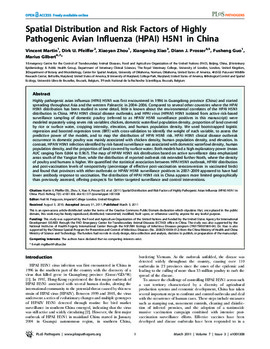| dc.contributor.author | Vincent Martin | |
| dc.contributor.author | Dirk U. Pfeiffer | |
| dc.contributor.author | Xiaoyan Zhou | |
| dc.contributor.author | Xiangming Xiao | |
| dc.contributor.author | Diann J. Prosser | |
| dc.contributor.author | Fusheng Guo | |
| dc.contributor.author | Marius Gilbert | |
| dc.date.accessioned | 2016-01-08T19:47:49Z | |
| dc.date.accessioned | 2016-03-30T15:32:56Z | |
| dc.date.available | 2016-01-08T19:47:49Z | |
| dc.date.available | 2016-03-30T15:32:56Z | |
| dc.date.issued | 2011-03-03 | |
| dc.identifier.citation | Martin V, Pfeiffer DU, Zhou X, Xiao X, Prosser DJ, Guo F, et al. (2011) Spatial Distribution and Risk Factors of Highly Pathogenic Avian Influenza (HPAI) H5N1 in China. PLoS Pathog 7(3): e1001308. doi:10.1371/journal.ppat.1001308 | en_US |
| dc.identifier.uri | https://hdl.handle.net/11244/23535 | |
| dc.description | | en_US |
| dc.description | | en_US |
| dc.description.abstract | Author Summary The geographical distribution of highly pathogenic avian influenza (HPAI) H5N1 and agro-ecological risk factors have been studied in a number of countries in Southeast Asia. However, little is know of its distribution in China where HPAI H5N1 first emerged in 1996, evolved, and spread throughout Asia and the western Palearctic in 2004–2006. This study analyzes separately the distribution, in domestic poultry, of HPAI virus (HPAIV) H5N1 isolated from active risk-based surveillance sampling and HPAI H5N1 clinical disease outbreaks. These data are analyzed in relation to the distribution of chicken and domestic waterfowl population density, proportion of land covered by rice or surface water, cropping intensity, elevation, and human population density. HPAI H5N1 viruses identified by risk-based surveillance are found to be associated with domestic waterfowl density, human population density, and the proportion of land covered by surface water. In contrast, HPAI H5N1 clinical disease outbreak occurrences were mainly associated with chicken density, human population density, and low elevation. These results show that the distribution of HPAI H5N1 risk in China appears more limited geographically than previously assessed, offering prospects for better targeted surveillance and control interventions. | en_US |
| dc.language.iso | en_US | en_US |
| dc.publisher | PLoS Pathogens | |
| dc.relation.ispartofseries | PLoS Pathog 7(3):e1001308 | |
| dc.relation.uri | http://www.plospathogens.org/article/info%3Adoi%2F10.1371%2Fjournal.ppat.1001308 | |
| dc.rights | Attribution 3.0 United States | |
| dc.rights.uri | https://creativecommons.org/licenses/by/3.0/us/ | |
| dc.subject | H5N1,China,Infectious disease surveillance,Population density,Poultry,Infectious disease control,Chickens,Waterfowl | en_US |
| dc.title | Spatial Distribution and Risk Factors of Highly Pathogenic Avian Influenza (HPAI) H5N1 in China | en_US |
| dc.type | Research Article | en_US |
| dc.description.peerreview | Yes | en_US |
| dc.description.peerreviewnotes | http://www.plospathogens.org/static/editorial#peer | en_US |
| dc.identifier.doi | 10.1371/journal.ppat.1001308 | en_US |
| dc.rights.requestable | false | en_US |

